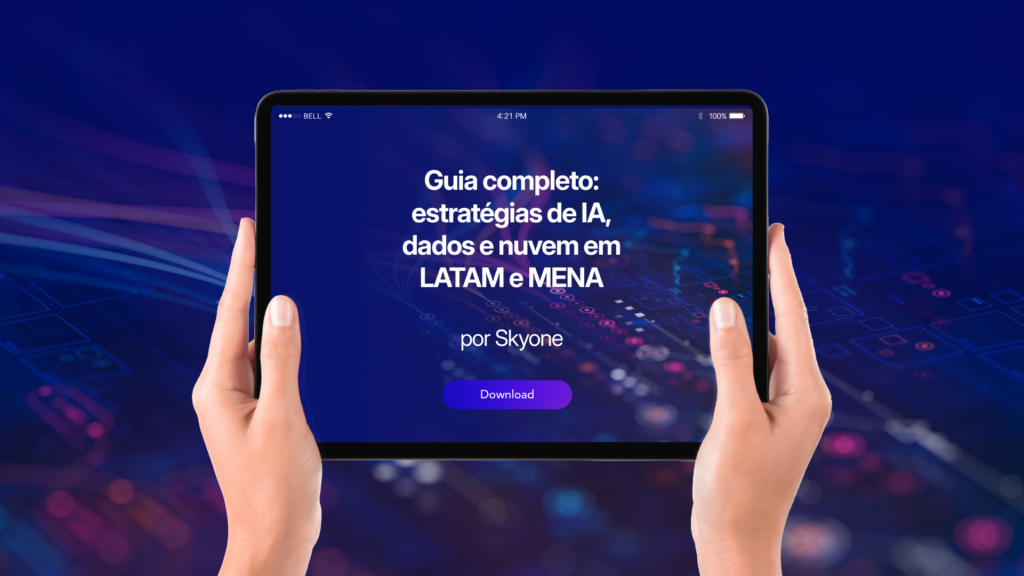1. Introduction
In the IT world, the biggest problem isn't always the failure itself. Often, it's the time it takes to detect it.
More distributed environments, interdependent systems, and constantly moving data have made operations more complex. And keeping everything under control now requires more than human effort: it requires intelligence .
According to Gartner , the urgency for automation is clear: by 2026, 30% of companies will automate more than half of their network activities, a movement driven by the need for greater efficiency and predictive capabilities.
And the market reflects this urgency: according to Fortune Business Insights , the AIOps sector was valued at $5.3 billion in 2024 and is projected to reach $44.1 billion by 2034 , a growth driven by the need for automation and real-time analytics.
It is in this scenario that AIOps is beginning to gain prominence . The acronym represents an approach that combines data, automation, and machine learning to give IT what it needs most: the ability to act before problems arise.
In this article, we'll explore how AIOps is transforming the logic of IT operations. We'll separate myths from reality and point out paths for those who want to evolve intelligently.
Enjoy reading!
2. What is AIOps and how does it work?
AIOps stands for Artificial Intelligence for IT Operations , meaning artificial intelligence applied to IT operations. Although still developing , this technology is already occupying a prominent place in discussions about the future of managing complex environments.
AIOps proposes a paradigm shift : using data, automation, and machine learning to make IT operations more intelligent and proactive. Instead of reacting to incidents after the impact has already been felt, the logic is to anticipate failures, correlate signals, and accelerate responses based on behavioral patterns.
According to Gartner , more than 40% of companies have already initiated some form of AIOps application , primarily in the early stages of monitoring and analyzing operational data.
But it's important to align expectations: AIOps isn't a " plug and play " solution. It requires a solid data foundation, system integration, and, above all, operational maturity. What we see today are companies taking their first steps, testing hypotheses, evaluating scenarios, and learning how to apply this intelligence to their real-world context.
In practice, AIOps is already beginning to be used in areas such as observability, monitoring, and anomaly detection. But full automation , with autonomous responses and predictive decisions, is still evolving , requiring time and investment to scale.
Therefore, it's wise to view AIOps not as a final destination, but as a new way of operating IT , starting small but already delivering concrete effects on a daily basis. That's what we'll discuss next.
3. What changes with AIOps in IT operations: features and benefits
Imagine an IT environment with hundreds of applications, dozens of integrations, and millions of events generated per hour. In such contexts, expecting humans alone to identify anomalies, cross-reference variables, and make timely decisions is not only inefficient: it's unsustainable .
AIOps fills this gap . It shifts the center of gravity of IT operations: instead of relying on linear, manual processes, we now operate with continuous intelligence, where algorithms absorb signals, correlate data, and suggest or execute actions based on history, patterns, and context.
This transition brings real changes to teams' daily lives:
- From isolated alerts to intelligent signal management : AIOps correlates logs , metrics, events, and traces in real time, connecting causes, grouping redundant alerts, and eliminating false positives. What once generated noise now transforms into focus and clarity;
- From manual reaction to automated response : By detecting recurring failure patterns, AIOps can autonomously execute mitigation routines, such as restarting a service, escalating a resource, or triggering priority support. This drastically reduces the MTTR ( Mean Time to Resolution) KPI and mitigates impacts to users;
- From reactive behavior to predictive intelligence : Over time, AIOps learns from the environment and anticipates unusual behaviors. It identifies, for example, that a certain volume of requests is likely to overload an API in the coming days, giving the team the opportunity to act before the problem occurs;
- From tacit knowledge to distributed intelligence : Machine learning transforms isolated experiences into replicable knowledge. Expertise no longer depends solely on the most experienced professionals, but can be applied by the entire team, based on real data and patterns.
- From disproportionate effort to measurable results : the consistent application of AIOps impacts strategic KPIs such as MTTD ( Mean Time to Detect), service stability, and technical team productivity, which gains time to evolve processes, instead of just putting out fires.
This new approach doesn't rely solely on technology; it requires a clear vision of where IT wants to go and which processes are ready to evolve intelligently. It's worth emphasizing that AIOps doesn't replace the team: it enhances its reach, distributes knowledge, and transforms the operation into a more resilient, connected, and strategic entity.
Now that we understand the practical impacts, it's time to explore existing approaches for applying AIOps efficiently and contextually. Shall we?
4. Types of AIOps: understand the possible approaches
There's no single path to implementing AIOps. Just as each IT operation has its own architecture, culture, and level of maturity, the adoption of operational intelligence also varies , and this begins with how AIOps connects with the environment.
Today, we can divide this journey into two main approaches: one focused more on specific domains, and another with a broader, more integrated vision. Both are valid, but they start from different perspectives and deliver distinct impacts.
4.1. Domain-Centric AIOps
In this model, AIOps is implemented within a specific technical context , such as infrastructure, network, database, or applications. In this model, intelligence operates on operational data from a single domain, focusing on solving local problems quickly.
It's a way to implement AIOps without relying on major restructuring , leveraging existing data and processes already in place.
Advantages :
- Faster and simpler implementation;
- Less dependence on integration between systems;
- Visible results in the short term.
Challenges:
- Limited view of the environment;
- Risk of isolated decisions, without global context;
- Low correlation between causes and effects of different areas.
This type of application is often the starting point for many companies , which then evolve to broader approaches as they gain confidence and structure.
4.2. Domain-Agnostic AIOps
Here, the proposal is more ambitious : AIOps acts transversally, analyzing data from multiple domains simultaneously , such as networks, applications, infrastructure, security, and others.
This approach allows us to view the environment as an interdependent system, where events in one area directly impact the performance of others. It's the ideal model for operations that already work with a consolidated database and seek smarter, more coordinated decisions .
Benefits:
- Holistic and integrated vision of the operation;
- Correlation between complex events from different sources;
- Increased predictive capacity and systemic automation
Challenges:
- Requires greater technical maturity and data governance;
- It depends on integration between tools and teams;
- Greater complexity in implementation and support.
This is the natural path for AIOps to evolve, and it also comes closest to realizing the promise of predictive, resilient, and autonomous operations.
These approaches aren't in competition. AIOps often begins in a specific domain and, as data is integrated and teams gain confidence , evolves into a broader, more strategic approach. As with everything, the important thing is to understand what makes sense now, without losing sight of where we want to go.
In the next section, we follow this logic and look at a concept directly linked to the evolution of AIOps: the new era of observability in IT.
5. AIOps and the future of observability in IT
Whereas observability was once seen as a technical function, restricted to graphs, logs , and alerts, today it takes on a much more strategic role. This is because the complexity of modern environments also requires understanding and anticipation. And this is where AIOps ceases to be merely an operational tool and becomes the "engine of intelligent observability .
While traditional approaches show what's happening, AIOps helps understand why it's happening, what the potential impact , and what can be done about it—often in real time.
And this transition marks the beginning of a new era for IT, for the following reasons:
- From monitoring to environmental narrative : observability ceases to be a collection of raw data and begins to build an integrated reading of the system's behavior, with connections between events, users and applications;
- From passive collection to contextual analysis : AIOps allows you to interpret signals based on history, patterns, and correlations, replacing manual reading with a continuous, machine learning- ;
- From ad hoc reactions to systemic understanding : problems are no longer treated as isolated events. With AIOps, observability shows how an error in one service can affect the entire chain, from infrastructure to the end customer.
- From technical metrics to business insights : the new generation of observability connects availability, performance, and user experience, providing input for strategic, not just operational, decisions.
This integrated view is what differentiates observability from monitoring. And AIOps is what makes this vision possible, interpreting data at scale, understanding the context, and identifying what needs attention before it becomes an incident.
It's important to emphasize: this intelligence only makes sense if there's a solid foundation of data and clear objectives behind it. AIOps doesn't transform on its own, but it enhances what IT has already built and accelerates the maturity of those ready to evolve.
And as always, we at Skyone are already participating in this journey, because our mission is to help build smarter, more resilient, and more strategic operations!
6. Where does Skyone fit into this conversation?
On the journey toward smarter operations, AIOps doesn't start with algorithms, but with structure. And this is where we make a difference.
With our data and integration platform, Skyone Studio, we enable an ecosystem where operational intelligence can flourish. We connect applications, centralize information, and create workflows that transform raw data into contextualized, real-time decisions.
In other words, we start with the right architecture . By structuring environments with lakehouses , automations with AI agents, and standardized integrations via iPaaS, we create the necessary conditions for AIOps models to be applied safely, contextually, and at scale.
Our purpose is to unlock digital evolution, and this includes preparing our clients for more autonomous, predictive, and strategic IT . Because more than predicting failures, the future of operations lies in predicting value. And we build this together, one connected data point at a time.
Every company is at a different stage. We're here to help you understand your current situation, identify what can be optimized now, and prepare for what comes next. If you'd like to discuss the next steps for your operation, speak with a Skyone specialist, and together we'll pave the way for your business's growth!
7. Conclusion
To talk about AIOps is to talk about operational maturity . More than applying artificial intelligence to systems monitoring, it's about transforming the way IT sees, understands, and responds to its own environment.
Throughout this article, like any change in logic , we've seen that AIOps is neither a magic solution nor an isolated resource. It begins with connected data, evolves with continuous learning, and only makes sense when inserted into a clear context, with well-defined objectives.
We've also shown that there's no single path: AIOps can start small , within a technical domain, and scale as the company's structure and culture evolve. The important thing is to take the first step responsibly and with a vision for the future.
At Skyone , we believe that paving this journey is as important as reaching the destination. Therefore, our mission is to prepare the groundwork , with organized data, efficient integrations, and secure automations, so that intelligence can, in fact, find room to grow.
How about continuing to advance on this topic? We recommend reading the article "How to Create a Realistic and Applicable AI Strategy for Your Company ," a great complement for anyone looking to make AIOps a viable and sustainable reality.
FAQ: Frequently Asked Questions about AIOps
Whether out of curiosity or practical necessity, understanding what AIOps is and how it works in IT routines can raise some questions. After all, we're talking about an evolving concept that's already beginning to deliver real value.
Below, we answer the most frequently asked questions to help you understand the concept, its role in operations, and its current stage of market adoption.
1) What is AIOps and what is its role in IT operations?
AIOps ( Artificial Intelligence for IT Operations ) is the use of artificial intelligence and machine learning to automate, analyze, and make IT operations more intelligent. Its role is to anticipate failures, correlate disparate signals, and accelerate data-driven responses, reducing incident detection and resolution times, as well as increasing system efficiency and stability.
While already bringing real gains in monitoring and observability for IT, AIOps is still evolving. This is because its more advanced application, with fully autonomous decisions and predictive responses, requires technical maturity, system integration, and a robust foundation of reliable data.
2) Does AIOps replace IT teams?
No. AIOps isn't here to replace IT professionals, but to enhance their capabilities. By taking on repetitive tasks, correlating data at scale, and suggesting actions based on patterns, it frees teams to focus on strategic decisions, innovation, and continuous improvement.
In practice, AIOps acts as an intelligent partner to the team, distributing knowledge and increasing operational responsiveness. Even so, its effectiveness depends directly on human input, both in configuration and supervision, as well as in the evolution of the applied models.
3) What is the difference between AIOps and traditional monitoring tools?
AIOps goes beyond traditional monitoring by using artificial intelligence to interpret real-time data, correlate events from multiple sources, and automatically suggest (or even execute) actions.
While conventional monitoring shows what's happening, AIOps seeks to understand why, predict what might happen, and act based on that context. It's an evolution of observability that transforms signals into smarter operational decisions.





